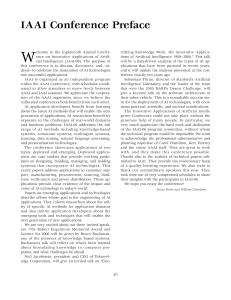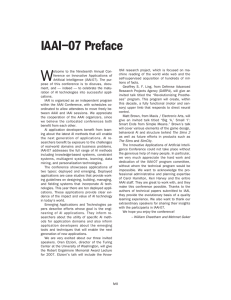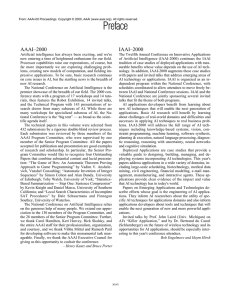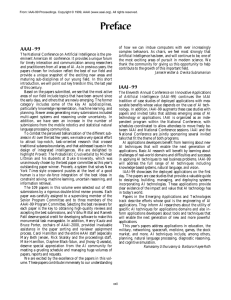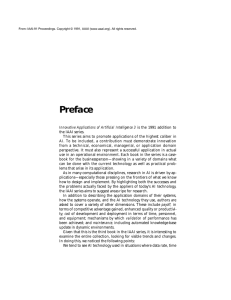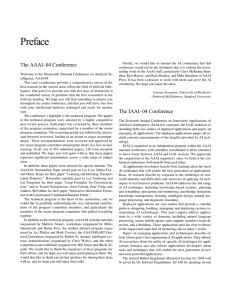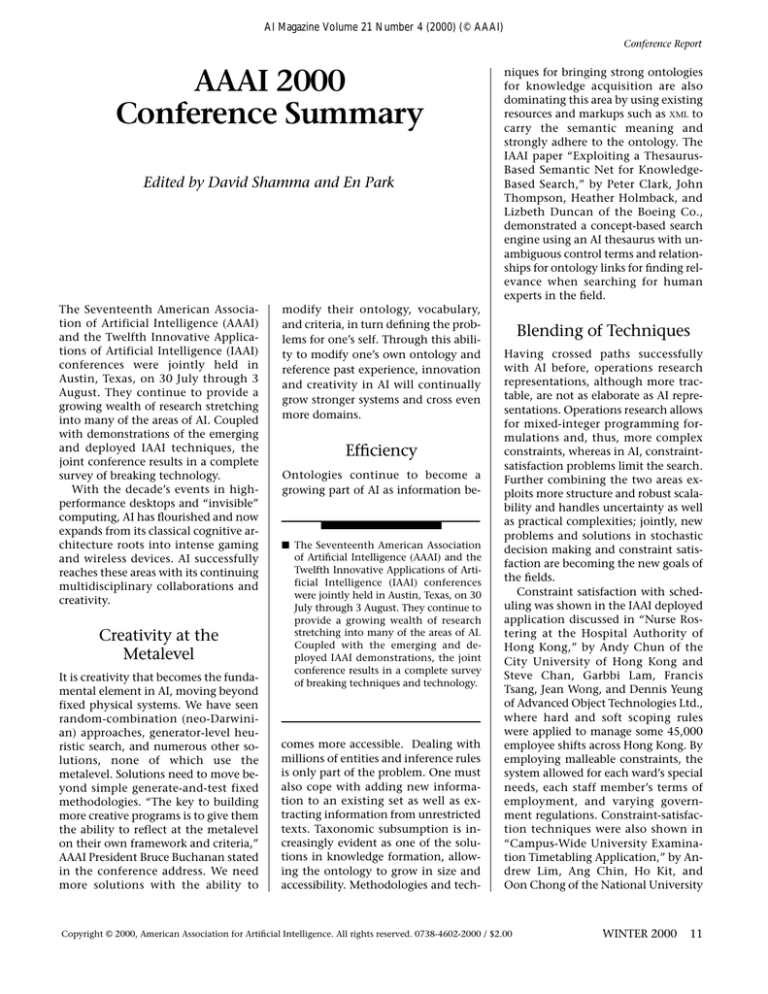
AI Magazine Volume 21 Number 4 (2000) (© AAAI)
Conference Report
AAAI 2000
Conference Summary
Edited by David Shamma and En Park
The Seventeenth American Association of Artificial Intelligence (AAAI)
and the Twelfth Innovative Applications of Artificial Intelligence (IAAI)
conferences were jointly held in
Austin, Texas, on 30 July through 3
August. They continue to provide a
growing wealth of research stretching
into many of the areas of AI. Coupled
with demonstrations of the emerging
and deployed IAAI techniques, the
joint conference results in a complete
survey of breaking technology.
With the decade’s events in highperformance desktops and “invisible”
computing, AI has flourished and now
expands from its classical cognitive architecture roots into intense gaming
and wireless devices. AI successfully
reaches these areas with its continuing
multidisciplinary collaborations and
creativity.
Creativity at the
Metalevel
It is creativity that becomes the fundamental element in AI, moving beyond
fixed physical systems. We have seen
random-combination (neo-Darwinian) approaches, generator-level heuristic search, and numerous other solutions, none of which use the
metalevel. Solutions need to move beyond simple generate-and-test fixed
methodologies. “The key to building
more creative programs is to give them
the ability to reflect at the metalevel
on their own framework and criteria,”
AAAI President Bruce Buchanan stated
in the conference address. We need
more solutions with the ability to
modify their ontology, vocabulary,
and criteria, in turn defining the problems for one’s self. Through this ability to modify one’s own ontology and
reference past experience, innovation
and creativity in AI will continually
grow stronger systems and cross even
more domains.
Efficiency
Ontologies continue to become a
growing part of AI as information be-
■ The Seventeenth American Association
of Artificial Intelligence (AAAI) and the
Twelfth Innovative Applications of Artificial Intelligence (IAAI) conferences
were jointly held in Austin, Texas, on 30
July through 3 August. They continue to
provide a growing wealth of research
stretching into many of the areas of AI.
Coupled with the emerging and deployed IAAI demonstrations, the joint
conference results in a complete survey
of breaking techniques and technology.
comes more accessible. Dealing with
millions of entities and inference rules
is only part of the problem. One must
also cope with adding new information to an existing set as well as extracting information from unrestricted
texts. Taxonomic subsumption is increasingly evident as one of the solutions in knowledge formation, allowing the ontology to grow in size and
accessibility. Methodologies and tech-
niques for bringing strong ontologies
for knowledge acquisition are also
dominating this area by using existing
resources and markups such as XML to
carry the semantic meaning and
strongly adhere to the ontology. The
IAAI paper “Exploiting a ThesaurusBased Semantic Net for KnowledgeBased Search,” by Peter Clark, John
Thompson, Heather Holmback, and
Lizbeth Duncan of the Boeing Co.,
demonstrated a concept-based search
engine using an AI thesaurus with unambiguous control terms and relationships for ontology links for finding relevance when searching for human
experts in the field.
Blending of Techniques
Having crossed paths successfully
with AI before, operations research
representations, although more tractable, are not as elaborate as AI representations. Operations research allows
for mixed-integer programming formulations and, thus, more complex
constraints, whereas in AI, constraintsatisfaction problems limit the search.
Further combining the two areas exploits more structure and robust scalability and handles uncertainty as well
as practical complexities; jointly, new
problems and solutions in stochastic
decision making and constraint satisfaction are becoming the new goals of
the fields.
Constraint satisfaction with scheduling was shown in the IAAI deployed
application discussed in “Nurse Rostering at the Hospital Authority of
Hong Kong,” by Andy Chun of the
City University of Hong Kong and
Steve Chan, Garbbi Lam, Francis
Tsang, Jean Wong, and Dennis Yeung
of Advanced Object Technologies Ltd.,
where hard and soft scoping rules
were applied to manage some 45,000
employee shifts across Hong Kong. By
employing malleable constraints, the
system allowed for each ward’s special
needs, each staff member’s terms of
employment, and varying government regulations. Constraint-satisfaction techniques were also shown in
“Campus-Wide University Examination Timetabling Application,” by Andrew Lim, Ang Chin, Ho Kit, and
Oon Chong of the National University
Copyright © 2000, American Association for Artificial Intelligence. All rights reserved. 0738-4602-2000 / $2.00
WINTER 2000
11
Conference Report
Photo: R. Skalsky.
The 2000 Urban Search and Rescue Event Brought Real-World Navigation and Sensing to AAAI’s Annual Robot Competition.
of Singapore, where researchers plan
on applying a weighted measuring
scheme to the problem of examination scheduling. Both applications
show creativity with flexibility yet
provide robust solutions.
New Perceptions
It is this deployed tangibility that continually increases AI awareness; growing visibility will continually dispel AI’s
missed perceptions because the field is
commonly not what people think. Successes such as DEEP BLUE and the Mars
Pathfinder have made AI more commonplace; Botball, as well as robotics
in general, and human-level AI (particularly in computer games) contribute
to this visibility, putting real-time action, autonomy, planning, and learning into our everyday roles. The future
lies in increasing agent technologies as
well as expanding AI web technologies
beyond search engines. Managing a
large wealth of information, an AI
problem for years now, and controlling
12
AI MAGAZINE
electronic commerce will become the
key AI web areas on which to concentrate. The answer lies in fusing solutions together, which will yield the
“killer app.”
Information and Interfaces
Although its unclear which area of AI
will bring such an application, handling the growing leviathan of information for easier retrieval continues to
present a strong focus. Combined with
the bigger, stronger ontologies, information retrieval and viewing are becoming a large focus in AI everywhere,
from databases to TV guides.
Content and constraint retrieval intelligently tailors enormous selections
into manageable lists. The conference
presented interfaces such as user profiling by the World Wide Web to interactive rule additions; viewing by HTML,
as well as the emergingly popular wireless application protocol (WAP), are also quite successful.
In the world of the increasingly in-
visible computer, we will see less user
intervention or interaction as the focus moves away from the web browser
and becomes part of the television,
cell phone, or other more ubiquitous
device. The intelligence of a device
will reside on nothing more than a
smart card. This entity, now independent of the device, will allow for personal notification and personal applications and exhibit intelligent
behaviors such as strong anytime
agent mobility.
Also a focus on the virtual application will be a variety of traditional and
nontraditional AI techniques to provide singular intelligent interfaces
across large domains of nonuniform
databases. “THEATERLOCI,” by Greg Barish, Craig Knoblock, Yi-Shin Chen,
Steven Minton, Andrew Philpot, and
Cyrus Shahabi of the University of
Southern California, showed new
ways of information extraction by
wrappers using a suboptimal local
search with postrefinement. The importance of these well-defined inter-
C&
Thought
omputers
Edward A. Feigenbaum
& Julian Feldman
EDITORS
ISBN 0-262-56092-5
560 pp., index
The AAAI Press • Distributed by The MIT Press
Massachusetts Institute of Technology, 5 Cambridge Center, Cambridge, Massachusetts 02142
To order, call toll free: (800) 356-0343 or (617) 625-8569.
MasterCard and VISA accepted.
Conference Report
Agents and agent interaction were again
a large presence at the conference.
faces, as well as extraction techniques,
shows a strong presence of AI techniques emerging as solutions to information abundance.
Agents
Agents and agent interaction were
again a large presence at the conference. Agent mobility shows new advances in the field where agents gather
information such as user data, timerelative queries, and database interaction and maximize limited-bandwidth
situations by migration. The IAAI paper entitled “Rapid Development of a
High-Performance Knowledge Base for
Course of Action Critiquing,” by Gheorghe Tecuci, Mihai Boicu, Dorin Marcu, Michael Bowman, Florin Ciucu,
and Cristian Levcovici of George Mason University, showed an agent disciple approach learning from an expert
and refining a knowledge base to simplify knowledge acquisition. User
communication is conducted more
naturally, but more formal methods
are used internally with the aid of a
shell to assist in ontology base management.
Justine Cassell of the Massachusetts
Institute of Technology Media Lab presented an embodied conversational
agent, ANNA NOVA, that leverages
knowledge of conducting conversation and relative intentions to an interface against theories of modality.
The goal is to use the body as a tool for
presenting availability clues as conversational systems to assist behaviors,
timing, and function.
To support the more accessible technologies, “The Emergence Engine: A
Behavior-Based Agent Development
Environment for Artists,” by Eitan
Mendelowitz of the University of California at Los Angeles, presented a system created for artists who have no
computer science background and
want to make computer-based worlds
dynamically generated in real time by
scripting. These worlds feature high
frame rates, stereo sound, and varying
modalities. Agent interaction—user to
14
AI MAGAZINE
agent and agent to agent—is dictated
by scripting high-level behaviors (including changing weights; creating
and destroying agents; playing media;
and communicating with, calling, or
spawning other scripts). This system
has successfully been installed in art
exhibits internationally.
“Defining and Using Ideal Teammate and Opponent Agent Models,”
by Peter Stone, Patrick Riley, and
Manuela Veloso of Carnegie Mellon
University, showcased optimal solutions for quick team agent decisions in
a large state and action space environment. By using a “what if I shoot
now?” approach called ideal modelbased behavior outcome prediction
(IMBBOP), pass or shoot decisions are
made successfully without the need to
maintain an extensive model of the
opponent. Many of the goals in the
prior competitions were used by these
breakaways or pass-shoot scenarios
given by this technique. Spectators at
the RoboSoccer event were aware of
the immense success of their technique.
Robotics
An overall push in mobile robotics is
the use of multiple robots that perform divide-and-conquer tasks. Coupled with recent advances in adding in
situ functions, the robot’s overall performance will be enhanced.
Robotics will move toward outdoor
navigation and vision navigation
techniques for complicated obstacle
avoidance, becoming one of robotics
main challenges. The field of vision is
becoming more empowered with
greater technologies, and digital cameras are now competing with traditional film cameras in spatial resolution. Thus, new techniques can extract
even more information and detail that
are oblivious to human vision. The
combination of modified optics and a
stronger computational representation will allow for more intelligent
and robust systems in the near future.
Embracing these trends, the 2000
Urban Search and Rescue event
brought real-world navigation and
sensing to AAAI’s annual robot competition. Each team’s robot navigated
through large and small debris fields as
well as identified victims and relayed
their locations. The heterogeneous
course showed varying levels of difficulty requiring adaptive intelligent solutions. THE ROBOT FROM SWARTHMORE
COLLEGE emerged victorious. Moving
forward in a developing world of robot
puppies and nomadic prospectors, the
AAAI contest continually challenges
and brings the latest technologies forward.
Gaming
One of the newer areas in AI is computer games. Given DEEP BLUE’s recent
achievements, AI research actively
moves forward in two-player perfectinformation games but also will show
applicable results in other areas of AI.
This year, we saw a small host of multiplayer game techniques in the technical papers and doubtlessly will see
more in years to come as gaming expands its reach.
High-performance computer gaming with dynamic virtual worlds has
become a recent focus in AI and was
strongly present at the conference. As
graphics computations are preempted
from the central processing unit,
greater than 5 percent can now be applied toward AI techniques. Here, the
need to dynamically respond to goals
in both action and role-playing games
reaches into many areas of AI (perception, speech processing, scheduling,
just to name a few). These games provide several research problems not only in character interaction but also
nonplayer characters (commentary,
scene rendering, and so on) and will
continue to advance toward stronger
challenges.
Conclusion
Bringing together disciplines with
stronger representations that reference
past experiences was the movement
seen at AAAI-IAAI 2000. We should see
even greater creativity and stronger,
more intelligent, more robust solutions next year!

